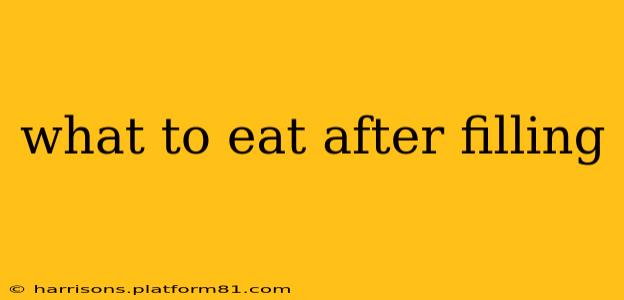What to Eat After a Filling? A Guide to Post-Filling Diet
Getting a dental filling is a common procedure, but knowing what to eat afterward is crucial for a smooth recovery and to protect your new filling. This guide will answer your questions about post-filling dietary restrictions and recommendations.
What should I eat after getting a filling?
Immediately after getting a filling, it's best to stick to soft foods for the first 24 hours. This allows the filling material to properly set and minimizes the risk of dislodging it or causing discomfort. Think:
- Yogurt: A great source of protein and calcium. Choose plain varieties to avoid added sugars.
- Applesauce: Smooth and easy to swallow.
- Mashed potatoes: A comforting and nutrient-rich option.
- Oatmeal (cooked): Gentle on the teeth and provides fiber.
- Scrambled eggs: A good source of protein.
- Smoothies: Blend fruits, vegetables, and yogurt for a nutritious meal. Avoid anything with ice, which could be too hard on your newly filled tooth.
After the initial 24 hours, you can gradually reintroduce other foods, but continue to avoid anything overly hard, crunchy, sticky, or chewy.
What foods should I avoid after a filling?
For at least the first few days, avoid these foods:
- Hard foods: Nuts, hard candies, ice, popcorn, etc. These can crack or dislodge your filling.
- Sticky foods: Caramels, taffy, gummy candies. These can pull at the filling and potentially cause damage.
- Chewy foods: Tough meats, bagels, etc. These can put excessive pressure on the filling.
- Extremely hot or cold foods and drinks: This can cause sensitivity around the filled tooth.
How long should I avoid certain foods after a filling?
While the first 24 hours are critical, it's generally recommended to avoid very hard, sticky, and chewy foods for at least a week to allow the filling to fully set and bond with the tooth. After that, you can gradually return to your normal diet. However, always be mindful of how your teeth feel. If you experience any discomfort, revert back to softer foods.
Can I eat anything right away after getting a filling?
No, it's crucial to wait for at least a few hours before consuming anything other than liquids. This allows the anesthetic to wear off completely and for the filling material to begin to set. Avoid chewing or biting until your dentist advises it is safe.
What if my filling hurts after eating?
If you experience pain or discomfort after eating, it's best to contact your dentist immediately. Pain could indicate a problem with the filling or an underlying dental issue. Don't delay seeking professional care.
How long does it take for a filling to completely set?
The time it takes for a filling to fully set varies depending on the type of filling material used. Your dentist will inform you of the specific time frame for your particular situation. Typically, it takes at least 24 hours for the initial setting.
By following these guidelines and paying attention to your body's signals, you can ensure a comfortable recovery and prolong the life of your new filling. Remember, regular dental checkups are essential for maintaining good oral health.
